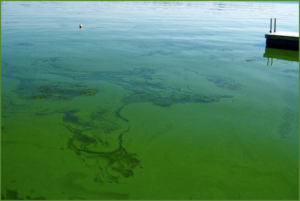One Bacteria, Different Names
The Problem
Cyanobacteria, commonly referred to as blue-green algae, typically bloom during the warm summer
months, when the lake waters are at their warmest temperatures. The algae thrive upon nutrients
typically used for agricultural use, such as phosphorous and nitrogen, which often leech into the
freshwater bodies as a result of run-off. As the algae blooms grow in size, so too does their toxicity
levels, resulting in toxic conditions along waterfront areas.
The Risk
Individuals most at risk of the effects of harmful algal blooms (HABs) are lakefront property owners.
These consist of residents who own property along a freshwater lake, and whom are the most
vulnerable to toxic algal blooms. These residents also represent the end-user of Eget Liber’s HAB
mitigation services.
Health and Safety
The problem with harmful algal blooms (HABs) is the interrupted use of the lakefront water resources
for the lakeside property owners. These harmful algal blooms have the ability to produce cyanotoxins,
or poisons that can threaten the life and safety of both humans and animals alike by attacking the
central nervous system and internal organs. In fact, such toxins have been known to kill dogs in as little
as 20 minutes after ingesting small quantities of the toxic water. The threat posed by these HABs often
prevents lakefront residents from utilizing the water at all.
How Big is the Problem
Harmful Algal Bloom (HABs) have increased exponentially over the last decade. In the year 2020 HABs are reported in all the 50 states. The problem is serious and needs attention immediately.





